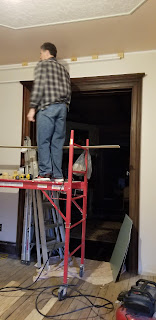While Chris worked on assembling the centerpiece for the ceiling I turned my attention to the ceiling trim. We decided to add a corbel feature to our ceiling trim. Since we could not purchase the corbels we wanted, I needed to make each one from different pieces of wood. I used two different pieces of chair rail with a hardboard backing to construct each piece. The corbels were constructed as one 8' long piece and then cut into individual pieces.
The corbels were painted and while they were drying I started on the board needed to attach the crown molding and the corbels.
After the crown molding was attached, then the corbels were spaced and attached to the underside of the board. I used a free online baluster calculator to determine the spacing.
The tower posed a different problem for us. I purchased some semi-flexible plastic trim but the curve was too much and the trim broke. (This is the beginning of my failed attempt).
We eventually purchased some resin poured flex trim which worked better and looked more professional. This is what the parlor looks like now with the ceiling centerpiece in place and the trim hung and painted. (The curtains are an added touch).
The corbels were painted and while they were drying I started on the board needed to attach the crown molding and the corbels.
After the crown molding was attached, then the corbels were spaced and attached to the underside of the board. I used a free online baluster calculator to determine the spacing.
The tower posed a different problem for us. I purchased some semi-flexible plastic trim but the curve was too much and the trim broke. (This is the beginning of my failed attempt).
We eventually purchased some resin poured flex trim which worked better and looked more professional. This is what the parlor looks like now with the ceiling centerpiece in place and the trim hung and painted. (The curtains are an added touch).





























